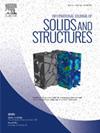Customized design of periodic metacushion with quasi-zero-stiffness for low-frequency vibration isolation
IF 3.4
3区 工程技术
Q1 MECHANICS
International Journal of Solids and Structures
Pub Date : 2025-06-11
DOI:10.1016/j.ijsolstr.2025.113518
引用次数: 0
Abstract
This paper develops an inverse design approach for periodic metamaterial with quasi-zero-stiffness (QZS) based on topology optimization. The customized design of QZS metacushion is realized with prescribed structure size and porosity factor. Finite element simulations (FEM) are performed on the optimized topological configuration while experiments are conducted on the fabricated periodic metacushion. Good agreement of force–displacement curves between two methods confirms the QZS feature in the quasi-static test. Vibration simulations and experiments validate the ability of periodic QZS metacushion on low-frequency vibration isolation. Moreover, the load-bearing capacity rises proportionally while the vibration isolation frequency drops with an increase of cell number in periodicity. In vibration tests, the deviation of objective payload significantly increases equivalent dynamic stiffness of metacushion, thus reducing the effect of vibration isolation in low-frequency ranges. In particular, the employment of periodic boundary in topology design results in lower frequency of vibration isolation as well as stronger robustness under non-uniform load, in comparison with free boundary. This work may provide an alternative approach for full-band vibration attenuation through the customized design of periodic QZS metacushion.
准零刚度低频隔振周期缓冲垫的定制设计
提出了一种基于拓扑优化的准零刚度周期性超材料的反设计方法。在规定的结构尺寸和孔隙率条件下,实现了QZS元垫层的定制设计。对优化后的拓扑结构进行了有限元仿真,并对制作的周期元垫进行了实验。两种方法的力-位移曲线吻合良好,证实了准静态试验的QZS特征。振动仿真和实验验证了周期性QZS缓冲层的低频隔振能力。随着单元数的增加,隔振频率呈周期性下降,而承载能力呈比例上升。在振动试验中,客观载荷的偏差显著增加了后垫的等效动刚度,从而降低了低频范围内的隔振效果。特别是,与自由边界相比,在拓扑设计中使用周期边界可以降低隔振频率,并且在非均匀载荷下具有更强的鲁棒性。本研究为周期性QZS元缓冲的定制化设计提供了一种全频带减振的替代方法。
本文章由计算机程序翻译,如有差异,请以英文原文为准。
求助全文
约1分钟内获得全文
求助全文
来源期刊
CiteScore
6.70
自引率
8.30%
发文量
405
审稿时长
70 days
期刊介绍:
The International Journal of Solids and Structures has as its objective the publication and dissemination of original research in Mechanics of Solids and Structures as a field of Applied Science and Engineering. It fosters thus the exchange of ideas among workers in different parts of the world and also among workers who emphasize different aspects of the foundations and applications of the field.
Standing as it does at the cross-roads of Materials Science, Life Sciences, Mathematics, Physics and Engineering Design, the Mechanics of Solids and Structures is experiencing considerable growth as a result of recent technological advances. The Journal, by providing an international medium of communication, is encouraging this growth and is encompassing all aspects of the field from the more classical problems of structural analysis to mechanics of solids continually interacting with other media and including fracture, flow, wave propagation, heat transfer, thermal effects in solids, optimum design methods, model analysis, structural topology and numerical techniques. Interest extends to both inorganic and organic solids and structures.

 求助内容:
求助内容: 应助结果提醒方式:
应助结果提醒方式:


